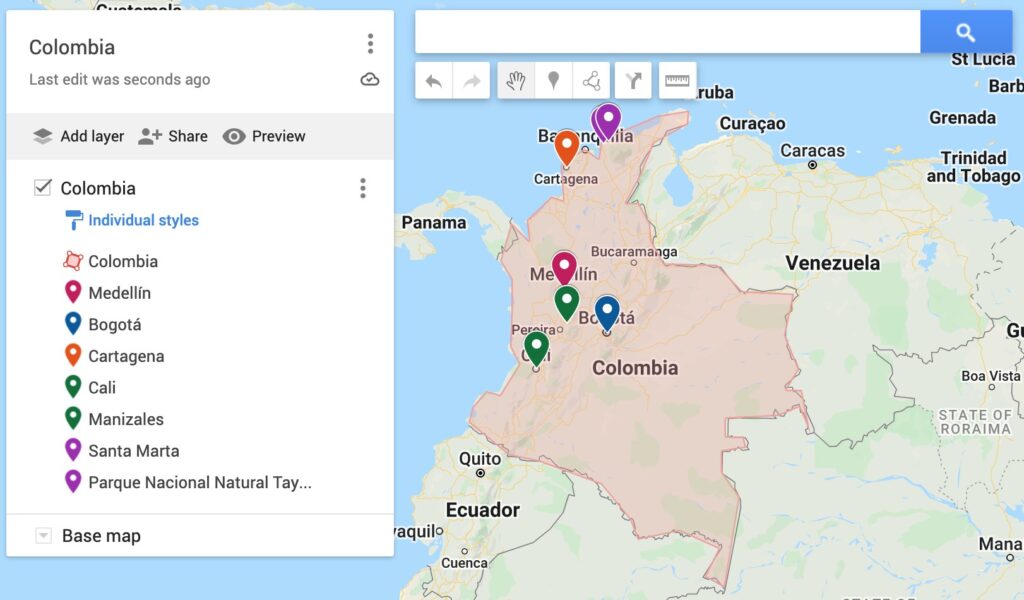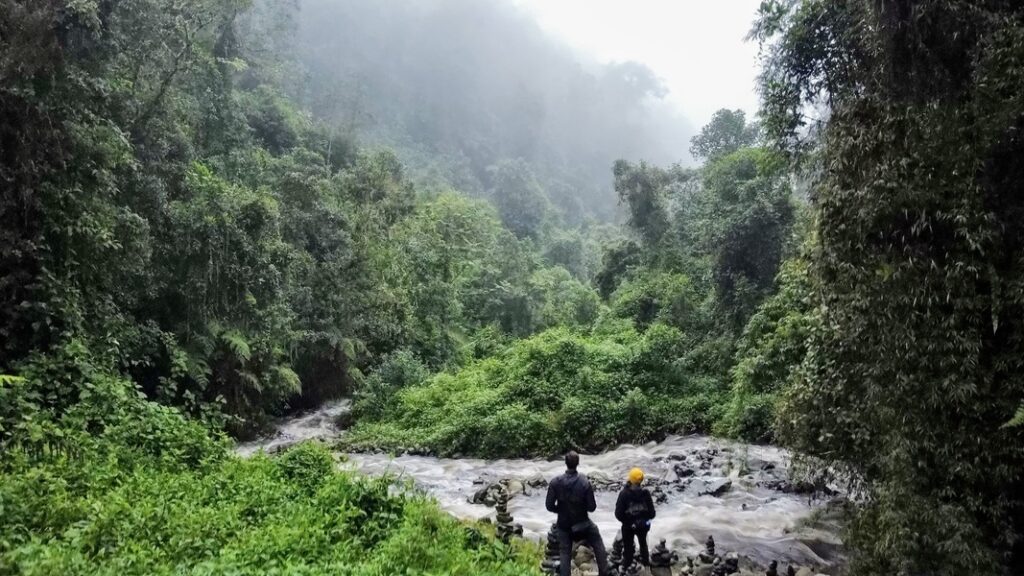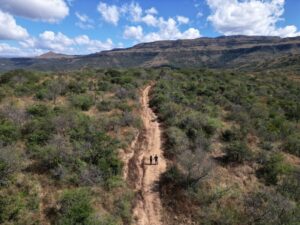General tips
When/where to go
Best time to visit: December to March is a popular time to visit as it is usually dry. The rainy season is the worst from April to September, so best to avoid. September to November is another popular time to visit, but remember it may still be rainy at higher altitudes. For more information regarding best times to travel to Colombia, check out this post by OnTheGo Tours.
Where to go:
- Medellin: Urban, hip & trendy, food/music/nightlife, young people, good jump off point to coffee fincas.
- Cartagena: Beach, colorful buildings, history, salsa.
- Bogota: Capital, more commercial, edgy, lots of food.
- Cali/Manizales: Coffee-triangle, jump-off point to Valle de Cocora, green valleys.
- Santa Marta/Tayrona: Coastal, jump-off point to Tayrona National Park & The Lost City, jungle + ocean.
Getting Around
Transportation: At the time of writing (01/2022) Uber and Lyft were not available in Manizales, although Uber was available in Medellin. There are however very cheap metered taxis all over Manizales which are easy to flag down just as you would in New York.
There is also a cable car which connects certain regions of Manizales together, although some stations are still being worked on. To get to neighboring cities, go to the bus station (any cab driver can take you there). It is full of different companies and it is easy to buy dirt-cheap (<5$) same-day tickets. Popular destinations will leave frequently, like every 20 minutes. You can also use the buses to get to Bogota, Medellin, or other further locations as well.
- Bring some comfortable walking shoes and be prepared for some hilly terrain. Some can be quite steep!
- Be very careful crossing streets in Manizales. Lots of fast cars on sharp turns. When in doubt, follow the locals.
- Manizales, as well as some other regions of Colombia such as Pereira, often utilize roundabouts instead of street lights. Also check the maps for small thin lines indicating staircases.
Localiza is the only place we could find to rent a car in Manizales. Be careful- google maps is outdated for a lot of Manizales and may show their old location. Their current location is in Mall Plaza, just inside of entrance #1. There are less automatic options so keep that in mind if you plan on renting a vehicle.
Gas stations: Most gas stations we came across had attendants who will fill your tank.
Public bathrooms: Some (like at the bus terminals or small coffee stops on the road) require a small entrance fee, so keep some small bills or change on you. No fee for bathrooms in the mall or restaurants.
Wi-Fi: Our Wi-Fi in most places around Manizales was decent but not the best. Makes sense when you’re up in some remote Colombian mountains.
Language
The official language of Colombia is Spanish. Those involved in tourism will often know a little English but knowing even a little Spanish can go a long way and it’s often very appreciated.
Greetings: It is common to exchange some form of “hello” when passing by others such as in an elevator or entering a store. Common phrases to use are “hola” or “buenas”.
Here are some basic Spanish phrases that you can use on your travels:
- Hola: Hello
- Buenos días: Good morning
- Buenas tardes:Good afternoon
- Buenas noches: Good evening
- ¿Cómo está? How are you?
- Gracias: Thank you
- Por favor: Please
- ¿Cómo te llamas? What’s your name?
- Me llamo ***: My name is ***.
- ¿Dónde está ***? Where is ***?
- El restaurante: The restaurant
- El hotel: The hotel
- La calle: The street
- El baño: The bathroom
- ¿Cuánto cuesta? How much does it cost?
- ¿Tiene ***? Do you have ***?
- ¿Habla inglés? Do you speak English?
- Mucho gusto: Nice to meet you
For more travel Spanish phrases, check out this blog post by Fluentu.com.
Food/Money
Money: The currency in Colombia is the Colombian peso (COP). At the time of our visit (Jan 2022) 1$ = approximately 4,000 COP. Yay geographic arbitrage!
ATM: Like most places in the world you can usually get the best conversion rates by pulling money from an ATM rather than going to a currency exchange. We had problems using some machines, but Davivienda and Bancolombia were reliable.
Tipping: 10% is usually listed as a voluntary service fee. Check you bill to see if service was already included. If not included, most places will ask if you’d like to tip the service (propina). Otherwise you’ll need to ask them to include it.
Restaurants/Cafés: We found service in general to be pretty relaxed, so be mindful if you are in a rush. Ask for the wifi password upfront in order to view the menu as the pandemic has popularized paperless menus. Many restaurants will ask to see your COVID19 vaccine card before seating you (our digital copies worked fine).
- If paying via credit card, tell them “tarjeta de crédito“. You may be asked for your “cellula” which is a Colombian ID number. Just tell them “soy extranjero” (I’m a foreigner) and you can show them alternate ID if needed (both our US driver’s license and passport worked fine).
- You may also be asked “¿cuantos quotas?” (How many times would you like to split the payment) to which you can respond “uno” (1 payment). It is common in Latin America to split bills into multiple payments.
Haggling: We didn’t really encounter any markets or situations where negotiating prices was indicated. Taxis are metered and most places have fixed pricing.
Foods To Try:
- Tinto: A small amount of black coffee.
- Arepas: You will find these everywhere. It’s like an extra fat tortilla. Sometimes stuffed with cheese and meats other times just served aside your breakfast. Not the healthiest, but if you’ve never had one definitely try.
- Carajillo: hot coffee + liquor. Originally from Spain but very popular in Colombia. Usually with rum or aguardente.
- Aguardiente: Liquor which tastes like black licorice.
- Torta: Small cakes usually served with coffee. I like to dip mine in an americano.
- Malteadas: Milk shakes.
- Batidos: Smoothies.
- Aguapanela con queso: Hot drink made of sugarcane water served with a block of cheese. Nice after a long hike in the cold rain.
- Pan de bono: Little balls of baked cheesy bread.
- Patacones: Fried green plantains usually served with hogoa (tomato onion salsa) but can also come with a variety of meat or cheese toppings.
- Aromatica: Infusion-like tea.
- Obleas: Thin, crunchy wafers with dulce de leche or fruit jams layered in between.
Fruits to Try:
- Granadilla: Like a sweeter cousin of passion fruit with crunchy seeds and a sweet membrane. You can break one open with some forceful thumb pressure and eat the boogery inside with a spoon.
- *Mangosteen: Like a hybrid of an orange, lychee and kiwi.
- Maracuya: Passion fruit with some crunchy seeds. Can have an intensely sour flavor, so better to have it in a smoothie or shake with some sweetener if it’s too much.
- Cherimoya: Similar to a sugar apple with a custard consistency. Cut in half and eat with a spoon.
- Mango biche: Spiralized mango with toppings such as lime.
For more Colombian foods to try, check out this post by Lacademie.
Health/Safety
Water: Same deal as most other developing nations, tap water not drinkable. Use a filter or buy bottled water. We travel with our Katadyn BeFree water bottle everywhere we go.
Street food: We love to eat street food! But you should always take caution to prevent catching a GI bug. Avoid anything that may have been washed in unfiltered water, such as salads or ceviche. Consuming undercooked meats, dairy or mayo products that look like they’ve been sitting out or old refried rice products can also lead to GI illness. Exercise caution and choose a place that appears to be using good hygiene and prepares your food in front of you (rather than prepared beforehand).
Safety: Colombia has a bad reputation due to the drug trade and kidnappings. We never felt unsafe in Colombia, but always use common sense: Don’t travel alone, avoid sketchy areas, only carry enough money for the day, don’t flash wealth. Only use official taxis, don’t drive alone at night, don’t accept drinks from strangers. Manizales, especially the Southeastern section, felt extremely safe and we never experienced any issues.
COVID-19
Per the US embassy website: “As of May 1, 2022, visitors to Colombia ages 18 or older will need to provide proof of complete vaccination for entry or a negative COVID test (48 hours in advance of travel for an antigen test or 72 hours in advance of travel for a PCR test). Travelers should be prepared to show their original, physical vaccination card or digital certificate both at airline check-in and when passing through Colombian Immigration.”
Many restaurants in Colombia will ask to see your COVID vaccination card prior to entry.
To return to the United States: “As of December 6, 2021, all air passengers 2 years or older, regardless of vaccination status or citizenship, must show a negative viral COVID-19 test taken no more than 1 day before travel to the United States.”
We were able to schedule a same-day, walk-in COVID test at SynLabs which have locations all over Colombia, including Bogota and Medellin. You can schedule your test through their website. Make sure you give a valid email address for your results, or just wait to pick up a printed copy (safer option).
map:
Check out our free Google Map of Colombia here with all of our recommendations here.






